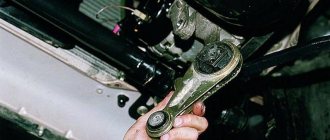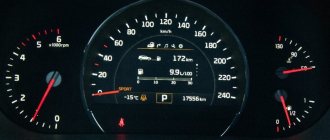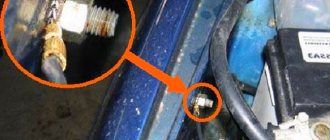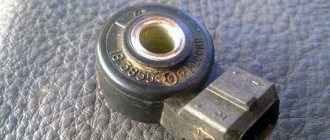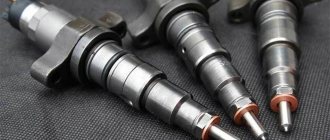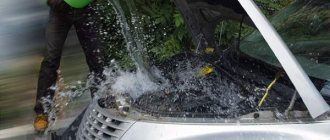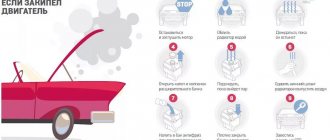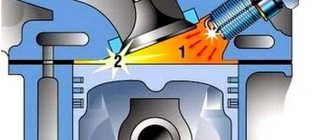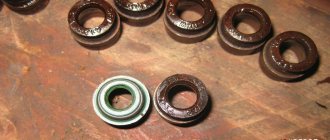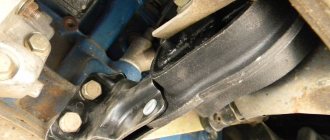Comfort in the car interior largely depends not only on properly made, high-quality noise and vibration insulation. Even if this is present, discomfort may still occur. Motorists often encounter engine vibrations. They can occur due to engine malfunctions or as a result of breakdowns of engine fasteners. Especially often, owners of cars from Avtovaz, where sixteen-valve power units are installed, complain about these problems. Car owners are faced with a strange knocking noise in the engine compartment. He is fickle. It may appear and then disappear during acceleration or when driving on uneven roads. The reason for this is a faulty engine mount. Signs of this phenomenon are vibrations. But that is not all.
Engine mount
A cushion is a gasket between the engine and body parts. On Soviet-made cars this product looked very simple. This is a durable rubber insert with places for fasteners. Modern power unit support can be of different designs. There are hydraulic cushions and rubber-metal parts. Often, the engine and gearbox on front-wheel drive vehicles are secured using four or five such supports. So, two of them are located under the gearbox, and the rest are under the engine. The rubber-metal support may look different.
Often this is a cylinder made of steel or aluminum, inside of which there is a rubber silent block. There is also a so-called lamp made of aluminum alloys with a rubber insert.
Design features
A rigid engine mount contributes to the transmission of noise into the car interior and increases the load on the internal combustion engine parts, since the body inevitably “plays” when driving over uneven surfaces. Therefore, vibration-damping materials are used in the design of the pillows. In modern automotive industry, several types of support designs are used:
- rubber-metal cushion. The units are fastened to metal elements, between which there is a layer of rubber. The silent blocks used in car suspensions have an identical design. This type of pillow is the most common because it has a long resource and low production cost. Some types of rubber-metal supports use springs to increase rigidity, as well as buffer elements to reduce shock loads. Rubber alloy or polyurethane is used as a damping material;
- hydraulic cushion. The operating principle is close to the operation of shock absorbers. The design of hydraulic mounts is more progressive, since it allows vibration damping to be adapted to the changing amplitude of engine and gearbox vibrations. The device assumes the presence of a working fluid, a membrane, upper (working) and lower (expansion) chambers, as well as a throttling channel. At idle speed, vibrations of the internal combustion engine are dampened by a membrane. As the speed increases, the rigidity of the membrane is not enough, so vibration damping begins to be carried out by hydraulic fluid. Thanks to this principle of operation, the cushion remains soft at idle, changing hardness only as engine speed increases.
We will not consider the design of electromagnetic and electrovacuum engine mounts, since they are found only on luxury cars, where replacing an engine mount with your own hands is a phenomenon bordering on science fiction.
Where is the engine mount located and what does it look like?
Mounts can mount the engine to a subframe, frame, or directly to the car body. The photo shows the main types of supports, so even a novice car enthusiast can find an internal combustion engine support on his car by analogy. To securely fix the motor, at least 3 pillows are used. The most commonly used scheme is with three lower and two upper supports.
DETAILS: Changing the oil in the VAZ 21099 carburetor engine. Photos, instructions on how to fill oil into a VAZ 21099 engine.
Diagnostics
To ensure that replacing engine cushions is not in vain, it is necessary to pay due attention to diagnostics. Main faults:
- subsidence of the rubber layer, as a result of which the metal parts of the support begin to contact, thereby transmitting vibrations from the cushions to the body (typical only for some types of construction);
- detachment of the rubber layer from the metal clips, which leads to looseness;
- the appearance of cracks and tears in rubber;
- destruction of the damping layer due to the ingress of engine oil or other technical fluids that corrode the rubber of the cushions;
- depressurization, as a result of which working fluid flows out of the hydraulic support (usually hydraulic fluid or propylene glycol, used in the manufacture of antifreeze);
- breaking off of a metal bracket (breakage is rare, but it does happen).
The check should begin with a visual inspection. If no obvious signs of malfunction have been identified, you need to start the engine. The upper cushions can be observed by opening the hood; the rear and side supports are most often clearly visible from the inspection hole. Ask an assistant to “turn” the engine, as vibrations can only manifest themselves at a certain speed.
Standard pillow arrangement
The right support is located on top and is attached to the side member of the car body. The front one is most often attached to the engine beam; you can see it from below.
The rear airbag can be found attached to the underbody or to the front subframe of the body. As for the rear support, on certain engines there may not be one at all. The gearbox support is used as a common one. It is installed closer to the rear side of the motor.
Typical faults
If the car is operated for a long time under conditions of severe loads or temperature changes, then all this does not have the best effect on the condition of the engine mounts. Over time, rubber loses its elasticity. In addition, the pillow may delaminate or crack, or even collapse. But it is worth considering that the service life of these parts is quite long - more than 100,000 km. The supports are subjected to high loads when the vehicle starts and during braking. If the car owner likes to drive fast enough, with sharp jerks at the start, then the supports will not last their intended period. Also among the typical faults is the breakdown of a metal aluminum bracket. This often happens when hitting a different obstacle. If there are oil leaks in the engine, it will definitely get onto the rubber part of the support. This lubricant can corrode the silent block and the support will fail. Coolant also does not have the best effect on the rubber part of the cushion. Breakdowns in the system must be eliminated immediately.
Do not overheat the engine. In addition to the cracked cylinder head, antifreeze from the expansion tank will also get onto the rubber parts. This will not have the best effect on their resource. It is important to remember that operating vehicles with broken mounts is not only unpleasant, but in some cases unsafe.
How to determine that the unit support has failed
Often, novice drivers do not know how to diagnose a faulty engine mount. Signs of such a breakdown are often confused with something else. The first signal that a support is broken is unpleasant sounds like clicking or knocking sounds in the front of the car when starting to move or when braking. Another sign is revealed when driving on uneven roads. Such a ride is necessarily accompanied by characteristic impacts in the front of the car. A sudden vibration can also indicate a malfunction of the airbag. Sometimes, when driving on bad roads, the gearshift lever may feel squeezing. This all indicates that there is a malfunction of the engine mount. These signs must be taken into account and then a diagnosis must be made. Sometimes it can be very difficult to determine if a support is broken. Typically, car enthusiasts attribute vibrations to the fact that the engine is not warm enough and often simply do not pay due attention to them. A characteristic sign that will tell you about the failure of a part is a creaking sound.
Consequences of untimely replacement
The engine support provides reliable elastic mounting of the engine to the body, which determines the level of vibration of the latter, and hence the sound insulation of the entire vehicle. Extreme wear is indicated by excessive background noise and clatter on poorly surfaced roads. You should not bring the details to this state, as this can lead to disastrous consequences:
- due to poor fastening of the engine, the air filter will hit the hood;
Most often, car power units are equipped with three supports, but there are models on which five such parts are installed. Experts recommend replacing everything at once, rather than one at a time.
In the video - what will happen if you do not replace the engine mount in a timely manner:
Diagnostic methods
So, the owner believes that the engine mount has failed. The symptoms of the malfunction were confirmed.
Next, you need to check the condition of the supports. In order to ensure the integrity of these parts, you will need a jack and any supports - wood stumps, pallets, tires. Anything will do. It is also advisable to prepare a crowbar or a thick stick. Let's look at how to determine if an engine mount is faulty. To do this, it is recommended to place the car on the most flat surface possible. Then the car needs to be lifted using a jack, then a prepared support should be installed under the engine. It could be a log or something else. It's better to remove the jack.
Removal and installation
If you look at the essence of the issue, you can replace the engine mounts yourself even with basic plumbing skills. Brief description of the process:
- we install wheel chocks, it is advisable to remove the “-” battery if the work will take place near the starter;
- dismantle the elements that block access to the fasteners;
- Using a small board or thick rubber, create a stop under the engine or gearbox near the cushion that needs to be replaced. The jack must be installed under the wall of the pallet to avoid dents. There is no need to create a lot of force, since the jack will only serve as a fulcrum. For engines and gearboxes with plastic trays, the stop must be found on the gearbox body or engine block;
- unscrew the mounting bolts and nuts. If, after unscrewing the nut, it turns out that the bolt is stuck and does not come out by hand, pry it off with a small lever. If you unscrew all the fasteners of the support, but it does not come out, try lowering or raising the engine a little with a jack. There is a possibility that the motor, being slightly distorted, pinched the pillow;
- Installation of a new support and assembly is carried out in the reverse order. As with removal, in order to install the support, you may have to adjust the position of the engine with a jack.
Checking the backlash
This option is used if there is a malfunction of the engine mount, all the signs are there, but nothing could be detected visually. It is necessary to check for play in the attachment of the engine mounts to the body.
For a full inspection, experts recommend using a stick or pry bar to rock the pillows from side to side. If you can find a large amount of play in the places where the engine mount is attached to the body, then you can carry out independent repairs. But you can also go to a service station and fix the problem there.
Motor mount: what does it look like and where to look?
In its simplest design, the support is a metal mounting bracket combined with a rubber-metal hinge - the so-called silent block. The rubber element in this case serves to dampen all kinds of engine vibrations, and also dampens sharp shocks that can be transmitted from the suspension.
These types of supports are the most common and are found in products of both the domestic automobile industry and foreign cars. By the way, recently polyurethane has been increasingly used in the construction of pillows instead of rubber - it is more durable.
Of course, there are more complex solutions, usually installed on premium cars. So, for example, hydraulic cushions, which are electronically controlled and can change their rigidity depending on the situation, are considered the pinnacle of technological progress.
Now let's try to find the engine mounts. Since their task is not only to dampen various vibrations, but also to securely mount the engine to the body so that it does not dangle in turns or jump on bumps, their location is clearly calculated.
The most common formula is 3+2: three airbags are located in the lower part of the engine and it is unrealistic to see them without climbing under the car, and two are installed in the upper part.
As for the exact mounting locations of the supports, they depend on the vehicle model, the configuration of the units, the location of the gearbox and other factors.
Signs of failure of the Lada Priora engine mount
VAZ cars are practically no different structurally from cars of any other manufacturers. The same applies to the design and location of parts such as engine mounts. Signs of a malfunction (including Priora) can be identified by characteristic engine vibrations. This occurs at idle and at higher speeds. The engine will jerk unnaturally.
This is a signal to the owner about the need to check the supports or replace them. The second sign is twitching of the steering wheel. The vibrations of the steering wheel depend on the operating frequency of the power unit. The gearbox can also tell you about failed airbags. When driving, the gears will be knocked out.
Tips and tricks
It is important to understand that the airbags experience the heaviest loads when the car suddenly starts from a standstill, as well as during heavy braking. The service life of the supports is also reduced by driving through potholes when the body and engine sway, especially at high speed.
As for diagnostics and repairs, it is necessary to check and change engine mounts in a timely manner, since increased vibrations not only affect comfort, but also have an extremely negative impact on the engine itself, the body and the equipment. In other words, even if one airbag is torn, it is strongly not recommended to further operate the car with such a malfunction.
Why might the engine vibrate at idle? Causes of malfunction, diagnostics. Tips and recommendations for reducing engine vibration levels.
Car engine mounts: purpose. Types of power unit supports and design differences. Signs of malfunctions of engine support cushions and inspection.
The engine twitches at idle: why does this happen? Engine jerking in idle mode, diagnostics of possible malfunctions, recommendations.
Replacing engine mounts: what are the signs that indicate that the cushions need to be changed? Types of support cushions, how to change engine mounts with your own hands.
Causes of vibration and unstable operation of a diesel engine in idle mode. Possible causes and fault diagnosis.
Ways to check the engine when choosing a used car: diagnostics by appearance, sound of operation, condition of spark plugs, color of exhaust gases, etc.
The car engine is quite heavy and subject to vibration, so it must be secured against any displacement during operation. If the fastening points are rigidly connected to the body elements, they will fail very quickly, since when driving over uneven road surfaces, the fastening points will absorb significant alternating loads.
Plus, the entire body will constantly vibrate, which, in addition to discomfort for those inside the car, will also negatively affect the durability of all elements of the car.
Purpose
Special supports, or cushions as they are also called, are used to dampen vibrations during engine operation and to securely fix it.
"Ford"
Vibrations on the car body at idle and while driving indicate that the engine mounts are out of order or damaged. Signs of malfunction (Ford Focus 2 as well) may be different. Ford Focus cars use two supports. The right one is hydraulic, the left one is the gearbox support. In case of damage, it is recommended to replace both elements.
Naturally, you can replace only the damaged one and the vibrations will go away, but the new support will be subjected to significantly greater loads and will fail much earlier than its intended life. As a replacement, it is worth purchasing original parts. Inexpensive analogues last less than 20 thousand kilometers.
"Mazda Demio"
Signs of a malfunction of the left engine mount of the Mazda Demio are knocking and vibrations. The supports bear a heavy load. It is worth carefully monitoring the condition of the airbags; a faulty part can damage the engine. This car has three airbags: left, right and bottom. The second is located near the engine oil filler neck. The left support is located under the battery. The lower one is located directly opposite the junction of the engine and automatic transmission. The methods for diagnosing a malfunction in this case are the same as for any other cars - this is a visual inspection and checking for play.
Conclusion
The engine mount not only protects the engine and transmission from premature wear, but also provides greater riding comfort. A routine inspection and simple diagnostics will allow you to determine the problem in advance, without waiting for unpleasant vibration to appear throughout the body. The appearance of additional noise distracts the driver from the road and increases the risk of an emergency. For this reason, every driver must be attentive to the “behavior” of his car and respond in a timely manner.
